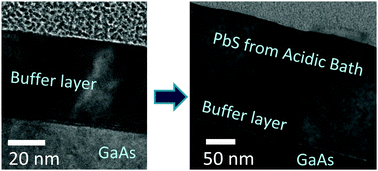The effect of deposition mechanism on the properties of epitaxial PbS films grown from acidic bath†
Abstract
We report on the deposition of epitaxial PbS thin films on GaAs(111) substrates from acidic solutions. A thin heteroepitaxial PbS buffer layer was initially deposited from alkaline solution to protect the GaAs substrate from the acidic environment. The buffer layer has a monocrystalline morphology, on top of which a thicker PbS film is homoepitaxially grown from acidic bath. The effect of pH on the quality of the PbS film was studied, where a sharp transition in the active deposition mechanism was obtained at pH = 3. Transmission infrared measurements were examined using the Urbach theory, indicating on the degree of order/disorder in the film. The results showed a transition point at pH = 3, signifying that samples grown at the transition point between deposition mechanisms include less defects and show better film quality. Deposition from acidic bath proved to be highly beneficial for doping semiconducting thin films without introducing high levels of impurities. While doping of PbS with Th from alkaline baths introduces high concentrations of oxygen to the films, deposition of PbS:Th films from acidic solutions resulted in controlled amounts of Th doping without increasing oxygen levels.



 Please wait while we load your content...
Please wait while we load your content...